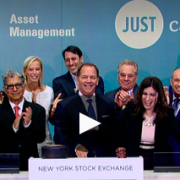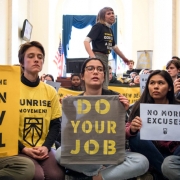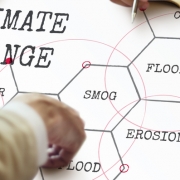I must disagree upfront with the overt criticism and vilification of Greta Thunberg, a 16-year-old actress (and daughter and granddaughter of actors) who looks as though she being manipulated — and fed her lines — by adult climate profiteers and alarmists who know full well what they are doing.
I watched her speech to the United Nations; her facial expressions and emotions come across as rehearsed and fabricated, much like those of an inexperienced thespian trying to play a difficult role. Even experienced actors who lack special training cannot, for example, portray convincing villains because it is clear that their gestures and emotions are rehearsed as opposed to genuine.
A skilled actor who knows the story can often improvise a performance for a specific scene even if he has not been given a script for it. “Greta Thunberg without a script to read from” suggests, on the other hand, that she does not really know the story and cannot play her role without a script. She punts at the end by saying, “I think you should give some questions to the others as well.”
Cui Bono: Who Benefits?
What motive would others have to use a teenage girl to support their agenda? The usual motive is money, and a lot of it: a Green New Deal for investment banks and other climate profiteers and a raw deal for everybody else. Senator Kirsten Gillibrand (D-N.Y.) wrote a 2009 opinion piece in the Wall Street Journal called “Cap and Trade Would be a Boon for New York” that bragged about how much money Goldman Sachs and J.P. Morgan Chase were going to make from this agenda. The late but unlamented Lehman Brothers was yet another company that hoped to profit from cap and trade.
David Vitter (R-La.) discussed this in “Legislative Hearing On S. 1733, Clean Energy Jobs And American Power Act”:
Senator Gillibrand wrote an insightful op-ed last week in the Wall Street Journal titled ‘Cap and Trade Could Be a Boon to New York.’ This article provided important insight into who will make money and how much. The Senator from New York stated that ‘carbon permits could quickly become the world’s largest commodities market, growing to as much as $3 trillion by 2020.’ That is $3 trillion that has to be generated by the work of America’s farmers, refiners, miners, small businesses and manufacturers and then redistributed to Wall Street. It will perhaps be the greatest transfer of wealth in U.S. history. And it may very well be the greatest scam ever thrust on the people of the United States. This program would be the equivalent of TARP in perpetuity for a handful of financial institutions that have already been bailed out once.
Vitter added, “Senator Dorgan recently stated that ‘I know the Wall Street crowd can’t wait to sink their teeth into a new trillion-dollar trading market in which hedge funds and investment banks would trade and speculate on carbon credits and securities. In no time they’ll create derivatives, swaps and more in that new market. In fact, most of the investment banks have already created carbon trading departments. They are ready to go. I’m not[.]”
Cui bono? Investment banks that handle but do not produce wealth, the kind of speculators that gave us the Great Depression and the more recent financial failures of 2008, and United Nations denizens that would love nothing more than to leech off the productivity of the United States and other industrialized nations, and all at the expense of working people around the world.
The Climate Activists Talk but Don’t Walk
Actions speak a lot more loudly than words, and those of the climate activists speak for themselves because they don’t walk their talk. Andrew Gilligan (2009)’s “Copenhagen climate summit: 1,200 limos, 140 private planes and caviar wedges” states that the airport expected 140 private jets, each of which emits far more carbon dioxide per passenger than commercial aircraft. “The top hotels — all fully booked at £650 a night — are readying their Climate Convention menus of (no doubt sustainable) scallops, foie gras and sculpted caviar wedges.”
The British pound is currently worth about $1.25 U.S., but it was closer to $1.50 in 2009, which means that the hotel rooms in question were roughly $1,000 a night. The December 2009 U.S. government per diem lodging reimbursement for Copenhagen was $290 per day, or roughly 30% of that, paid by the climate conference attendees. Employees of the U.S. government, employees of corporations, and consultants and contractors whose customers pay for their lodging do not get to stay in $1,000 or even $500 hotel rooms, or fly in anything but coach on a commercial aircraft.
This is far from an isolated example. Celebrities used private jets to attend Google’s 2019 climate change summit in Sicily, thus reinforcing the perception that they do not really believe that greenhouse gas emissions are a problem, or, if they do, they simply do not care.
We Aren’t Doing “Nothing”
Contrary to Thunberg’s assertion “How dare you continue to look away and come here saying that you’re doing enough, when the politics and solutions needed are still nowhere in sight,” the world’s makers (power, manufacturing, construction, chemical, and transportation industries), as opposed to the takers (climate profiteers and United Nations), have been acting to reduce the waste of energy, and therefore unnecessary carbon emissions, for years. The U.S. Department of Energy promotes the ISO 50001 standard for energy management systems, which calls on organizations to identify significant energy uses and also gaps between current and potential (lower) energy consumption. Leadership in Energy and Environmental Design (LEED) promotes the design of energy-efficient and also water-efficient buildings that save money for their owners and tenants rather than climate profiteers. The United States government has promoted Energy Star appliances for decades.
Engineers and scientists, as opposed to celebrities and U.N. delegates, also gave us the light-emitting diode (LED) bulb that costs less than a fifth as much as a traditional incandescent bulb to operate. Indian engineers have meanwhile given us the Tuticorin coal-fired power plant that converts its carbon dioxide into a saleable byproduct, and at a profit. Japan’s setsuden (energy saving) campaign is yet another positive role model worthy of imitation. We should continue to look to the world’s producers, and the world itself, rather than its parasites for genuine energy-saving solutions that put money into the pockets of the world’s makers rather than its takers.













